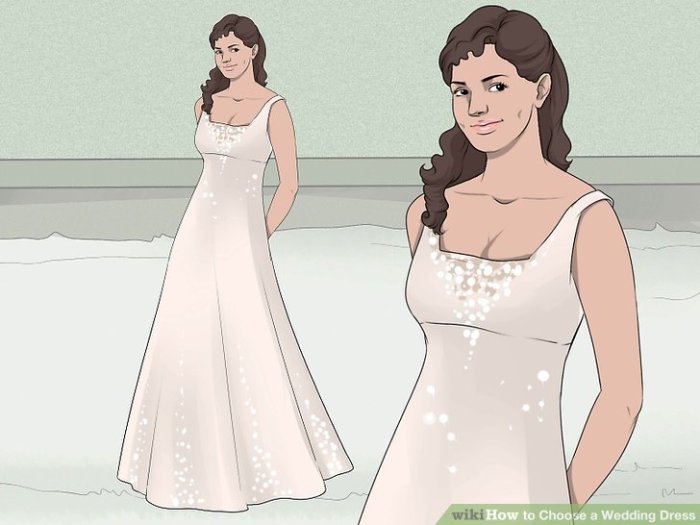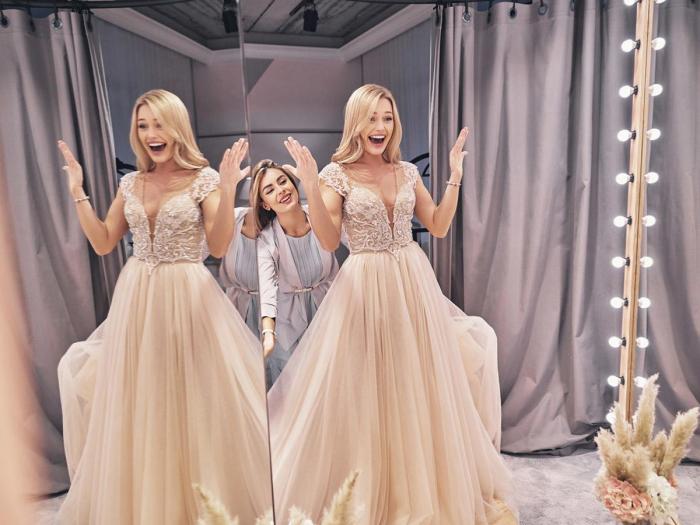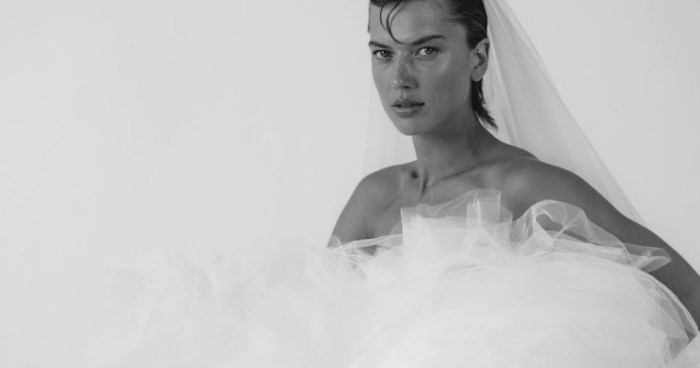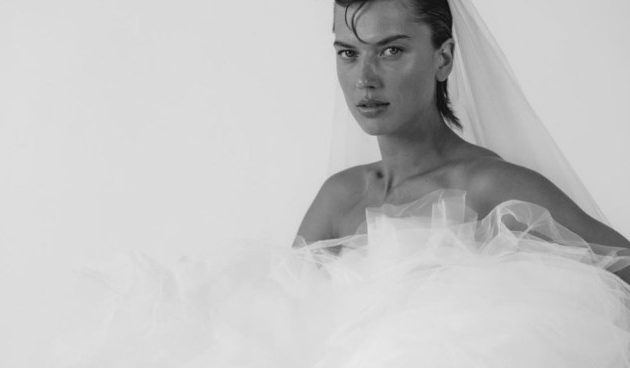Understanding Your Body Shape and Style
How to pick a wedding dress – Choosing a wedding dress that flatters your figure is crucial for feeling confident and radiant on your big day. Understanding your body shape and identifying silhouettes that accentuate your best features will significantly streamline your dress shopping experience. This section will guide you through identifying your body type and selecting the most suitable dress styles and necklines.
Body Shapes and Flattering Necklines
Different body shapes are best complemented by different necklines and silhouettes. Consider these suggestions as a starting point, and remember that personal preference plays a vital role.
| Body Shape | Flattering Necklines | Suitable Silhouettes | Things to Avoid |
|---|---|---|---|
| Hourglass | Sweetheart, V-neck, scoop neck | A-line, fit-and-flare, mermaid (depending on preference) | Boxy or shapeless styles |
| Pear | V-neck, sweetheart, off-the-shoulder | A-line, ballgown, empire waist | Strapless, styles that add volume to the hips |
| Apple | V-neck, empire waist, bateau | A-line, empire waist, sheath (with strategic detailing) | Fitted styles that emphasize the midsection |
| Rectangle | Sweetheart, halter, square neck | A-line, ballgown, fit-and-flare | Straight, shapeless styles that lack definition |
| Inverted Triangle | V-neck, scoop neck, off-the-shoulder | A-line, ballgown, empire waist | Strapless, styles that add volume to the shoulders |
Fabric Choice and Body Shape
Fabric plays a significant role in how a dress drapes and flatters your figure. Heavier fabrics like brocade or satin can add structure and definition, while lighter fabrics like chiffon or tulle can create a more flowing and ethereal look. For example, a pear-shaped bride might choose a flowing A-line gown in chiffon to balance her proportions, while an hourglass figure could be beautifully showcased in a structured satin mermaid gown.
Defining Your Wedding Style and Theme
Your wedding dress should reflect your personal style and the overall theme of your wedding. Consider the atmosphere you want to create and choose a dress that complements the venue and overall aesthetic.
Wedding Dress Styles
Several distinct wedding dress styles cater to diverse preferences. Understanding these styles will help you narrow down your options and visualize your dream look.
- Bohemian: Flowing fabrics like lace and chiffon, often featuring intricate embroidery, delicate beading, and relaxed silhouettes. Think free-spirited and romantic.
- Classic: Timeless elegance defined by clean lines, simple silhouettes (A-line, sheath), high-quality fabrics like silk or satin, and minimal embellishments. Exudes sophistication and understated glamour.
- Modern: Bold silhouettes, architectural details, unique necklines, and often incorporates contemporary fabrics and textures. Projects a sleek, chic, and forward-thinking aesthetic.
- Rustic: Natural fabrics like linen or cotton, often featuring lace or embroidery, and relaxed silhouettes. Embraces a warm, earthy, and charming aesthetic.
Mood Board Illustrations
Visualizing your ideal wedding dress style through a mood board is beneficial. Imagine a mood board for each style above. For example, the Bohemian mood board would showcase flowing fabrics like chiffon and lace, images of floral crowns, and natural settings. The Classic mood board would feature images of sleek A-line gowns in silk, simple jewelry, and elegant venues.
The Modern mood board would include geometric patterns, architectural details, and sleek, minimalist settings. The Rustic mood board would showcase natural fabrics, wildflowers, and rustic barn venues.
Wedding Style and Venue Suitability
The venue significantly influences dress selection. A flowing bohemian gown might be perfect for a beach wedding, while a classic ballgown would suit a grand ballroom. A modern sheath dress would complement a minimalist urban setting, and a rustic gown would fit perfectly in a barn or vineyard.
Budget and Shopping Strategies: How To Pick A Wedding Dress
Setting a realistic budget and developing a strategic shopping plan are essential for finding your dream dress without exceeding your financial limits.
Setting a Realistic Budget

Source: wikihow.com
Allocate a specific percentage of your overall wedding budget to the dress. Consider factors like alterations, accessories, and potential sales tax when determining your spending limit. Research average dress prices in your area to get a realistic expectation.
Step-by-Step Dress Shopping Plan, How to pick a wedding dress

Source: weddingdressesguide.com
A structured approach will make your dress shopping less overwhelming. Begin by researching different styles and designers. Then, schedule appointments at bridal salons, keeping your budget and style preferences in mind. Try on several dresses to get a feel for different silhouettes and fabrics. Finally, select your dress and schedule alterations.
Potential Shopping Locations
Numerous options exist for purchasing wedding dresses, each catering to different budgets and styles.
| Store Type | Price Range | Style Selection |
|---|---|---|
| Bridal Salons | Mid-range to high-end | Wide variety of styles and designers |
| Department Stores | Mid-range | More limited selection, but often convenient |
| Online Retailers | Wide range | Diverse selection, but requires careful consideration of sizing and returns |
| Sample Sales | Discounted | Limited selection, but potential for significant savings |
Choosing the Right Accessories
Accessories play a vital role in completing your wedding day look, adding personality and enhancing your overall style.
Importance of Accessories
Accessories like veils, jewelry, and shoes can elevate your wedding dress, reflecting your personal style and adding the finishing touches to your ensemble. A simple veil can add elegance, while statement jewelry can create a bolder look. The right shoes will ensure comfort and style throughout the day.
Accessory Examples and Impact
A long cathedral veil adds drama and romance, while a birdcage veil offers a vintage touch. Delicate pearl earrings can complement a classic gown, while bold chandelier earrings suit a more modern style. Comfortable heels or flats ensure you can dance the night away.
Accessory Checklist
- Veil
- Jewelry (earrings, necklace, bracelet)
- Shoes
- Undergarments
- Hair accessories (if needed)
- Handbag (for essentials)
The Wedding Dress Shopping Experience
The process of finding your wedding dress should be enjoyable and empowering. Preparation and effective communication will make the experience more positive and efficient.
Trying on Wedding Dresses
Schedule appointments in advance, and bring supportive friends or family members for their opinions. Be open to trying different styles and silhouettes, even those outside your initial preferences. Take photos and videos to help you remember each dress.
Communicating with Bridal Consultants
Clearly communicate your budget, style preferences, and body shape to the consultant. Ask questions, express your concerns, and don’t hesitate to seek a second opinion if needed. A good consultant will guide you and provide helpful suggestions.
Saying “Yes” to the Dress
Trust your instincts. When you find the dress that makes you feel beautiful, confident, and excited, you’ll know it’s the one. Don’t overthink it; focus on how the dress makes you feel.
Fabric and Construction Details
Understanding wedding dress fabrics and recognizing quality construction are key to ensuring a durable and beautiful gown that will last a lifetime.
Wedding Dress Fabrics
Different fabrics offer unique properties, impacting the drape, texture, and overall look of the dress. Consider the season and style when selecting your fabric.
| Fabric Type | Pros | Cons | Best Suited For |
|---|---|---|---|
| Silk | Luxurious, drapes beautifully, breathable | Expensive, requires delicate care | Classic, elegant styles |
| Satin | Shiny, smooth, creates a sleek silhouette | Can be unforgiving on certain body types | Modern, sleek styles |
| Lace | Romantic, intricate detailing, adds texture | Can be itchy or uncomfortable for some | Bohemian, romantic styles |
| Tulle | Lightweight, airy, creates volume | Can be delicate and easily damaged | Romantic, ballgown styles |
Identifying High-Quality Construction
Examine the seams for even stitching, check for clean finishing, and ensure the lining is smooth and comfortable. Look for quality zippers and buttons, and assess the overall craftsmanship. A well-constructed dress will feel luxurious and durable.
Alterations and Fittings

Source: thewed.com
Professional alterations are crucial for achieving a perfect fit and ensuring your dress looks its best on your wedding day.
Importance of Professional Alterations
Even a well-fitting dress often requires alterations to ensure a flawless fit. A skilled seamstress can adjust the length, waistline, and other details to create a custom fit that enhances your figure and complements your style.
Stages of the Wedding Dress Fitting Process
Typically, several fittings are required. The first fitting involves basic measurements and adjustments. Subsequent fittings focus on fine-tuning details like the length, hemline, and overall fit. The final fitting ensures everything is perfect before the wedding.
Alterations Timeline
Allow ample time for alterations, ideally scheduling the first fitting several months before the wedding. This allows for adjustments and potential delays without compromising the timeline.
Preserving Your Wedding Dress
Proper cleaning and storage are essential for preserving your wedding dress, allowing you to cherish this special garment for years to come.
Cleaning and Storing Your Wedding Dress
Have your dress professionally cleaned as soon as possible after the wedding. Avoid attempting to clean it yourself, as this can damage the fabric. Store the dress in a breathable garment bag in a cool, dry place, away from direct sunlight and moisture.
Professional Preservation Services
Professional preservation services offer expert cleaning, repair, and storage solutions. They use specialized techniques and materials to protect your dress from damage and ensure its longevity.
Long-Term Storage Options
Consider storing your dress in a climate-controlled environment, such as a dedicated preservation box or archival storage. Avoid storing it in attics, basements, or other areas prone to temperature and humidity fluctuations.
Choosing your wedding dress involves careful consideration of style, budget, and personal preference. A significant factor in budgeting is understanding the price range of designer gowns; for example, if you’re considering a Berta gown, you’ll want to research how much are Berta wedding dresses beforehand. This will help you realistically assess your options and refine your search for the perfect dress that fits both your style and your financial plan.
FAQ Compilation
What if I can’t find my perfect dress in my budget?
Consider shopping off-season, looking at sample sales, or choosing a simpler style with fewer embellishments to stay within your budget.
How far in advance should I start looking for a wedding dress?
Ideally, begin your search 9-12 months before your wedding to allow ample time for alterations and potential delays.
What should I bring to my wedding dress appointments?
Bring comfortable undergarments, shoes similar to what you plan to wear on your wedding day, and photos of dresses you like for inspiration.
What if I fall in love with a dress that needs extensive alterations?
Be realistic about the cost and timeline of alterations. Ensure the alterations are possible and within your budget before committing to the dress.
Can I bring a lot of people to my appointments?
While it’s exciting to share the experience, limit your entourage to a few trusted individuals whose opinions you value to avoid feeling overwhelmed.

